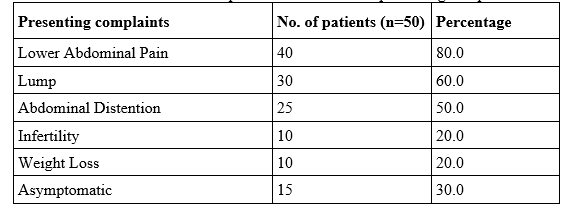Role of multi-detector computed tomography in characterization of ovarian masses with cyto-histopathological correlation
Abstract
Background: Ovarian cancer continues to pose a major challenge to physicians and radiologists. Besides clinical examination, CA 125 levels, and ultrasonography, CT scan is also used as a diagnostic technique for ovarian carcinoma and is superior to US in assessment of the nature of ovarian masses. With the advent of MDCT, it has become possible to acquire several thin slices and image reconstruction in axial, coronal and sagittal planes contributing valuable information towards preoperative surgical and management planning. Objectives: To evaluate the diagnostic accuracy of MDCT to differentiate between benign and malignant ovarian masses and to compare the findings with cyto- histopathological results. Materials and methods: This study was conducted in the department of Radio diagnosis, Dr. Balasaheb Vikhe Patil rural medical college and Dr. Vitthalrao Vikhe Patil Pravara Rural hospital, Loni BK, 413736 during the period of April 2021 to June 2022.CT imaging findings of 50 patients with ovarian masses were compared with cyto-histopathological results. Sensitivity, specificity, positive predictive value (PPV), negative predictive value (NPV), and diagnostic accuracy of MDCT were calculated. Results: 50 cases were evaluated by Computed Tomography; total 60 lesions were found (10 bilateral / 50 unilateral). Benign ovarian lesions were present in 28 patients whereas malignant ovarian lesions were present in 22 patients based on Computed Tomography. Cyto/histopathological correlation revealed benign lesions in 30 patients and malignant lesions in 20 patients. The sensitivity, specificity, PPV, NPV and diagnostic accuracy of Computed Tomography was found to be 90.0%, 86.6%, 89%, 85% and 90.0%. Conclusion: MDCT imaging offers a safe, accurate and noninvasive modality to differentiate between benign and malignant ovarian masses.
Downloads
References
Silverberg E, Boring CC, Squires TS (1990). Cancer statistics. Cancer, 40, 9-26.
Tanwani AK (2005). Prevalence and pattern of ovarian lesions. Ann Pak Inst Med Sci, 1, 211-4.
Landis SH, Murray T, Bolden S, Wingo PA (1998). Cancer statistics. Cancer, 47, 6-29.
Woodward PJ, Hosseinzadeh K, Saenger JS (2004). Radiologic staging of ovarian carcinoma with pathologic correlation. Radiographics, 24, 225-46.
Yasir Jamil, Saima Hafeez, Tariq Alam, Madiha Beg, Mohamma Awais, Imrana Masroor (2013) et al Ovarian masses: is multi-detector computed tomography a reliable imaging modality?
Parrish FJ (2007). Volume CT: state-of-the-art-reporting. Am J Roentgenol, 189, 528-34.
International Journal of Women’s Health 2011:3 123–126 role of multidetector computed tomography (MDCT) in patients with ovarian masses.
Kinkel K, Lu Y, Mehdizade A, Pelte MF, Hricak H. Indeterminate ovarian mass at ultrasound: incremental value of second imaging test for characterization-meta analysis and Bayesian analysis. Radiology. 2005; 236:85–94.
Tsili AC, Tsampoulas C, Charisiadi A, et al. Adnexal masses: accuracy of detection and differentiation with multidetector computed tomography. Gynecol Oncol. 2008; 110:22–31.
LiuY. Benign ovarian and endometrial uptake on FDGPET-CT: patterns and pitfalls. Ann Nucl Med. 2009; 23:107–112.



























